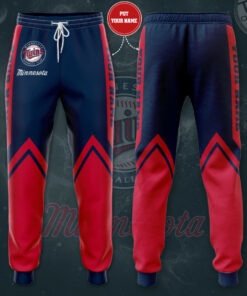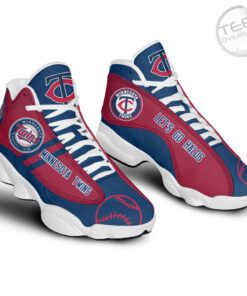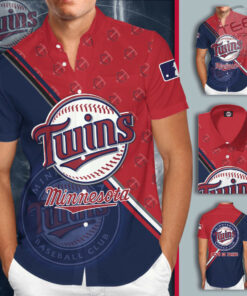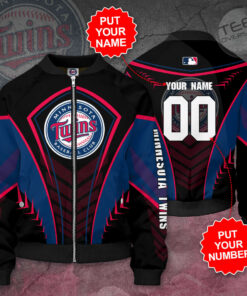The Minnesota Twins are an American professional baseball team based in Minneapolis. The Twins compete in Major League Baseball as a member club of the American League Central Division. The team is named after the Twin Cities area which includes the two adjoining cities of Minneapolis and St. Paul.
The franchise was founded in Washington, D.C., in 1901 as the Washington Senators. The team moved to Minnesota and was renamed the Minnesota Twins for the start of the 1961 season. The Twins played in Metropolitan Stadium from 1961 to 1981 and in the Hubert H. Humphrey Metrodome from 1982 to 2009. The team played its inaugural game at Target Field on April 12, 2010. The franchise won the World Series in 1924 as the Senators, and in 1987 and 1991 as the Twins.
From 1901 to 2021, the Senators/Twins franchise's overall regular-season win–loss–tie record is 9,012–9,716–109 ; as the Twins, it is 4,789–4,852–8.
Team history
Washington Nationals/Senators: 1901–1960
The team was founded in Washington, D.C., in as one of the eight original teams of the American League. It was named the Washington Senators from 1901 to 1904, the Washington Nationals from 1905 to 1955, and the Senators again from 1956 to 1960. But the team was commonly referred to as the Senators throughout its history. The name "Nationals" appeared on uniforms for only two seasons, and then was replaced with the "W" logo. The media often shortened the nickname to "Nats" — even for the 1961 expansion team. The names "Nationals" and "Nats" were revived in 2005, when the Montreal Expos moved to Washington to become the Nationals.
The Washington Senators spent the first decade of their existence finishing near the bottom of the American League standings. The team's long bouts of mediocrity were immortalized in the 1955 Broadway musical Damn Yankees. Their fortunes began to improve with the arrival of 19-year-old pitcher, Walter Johnson, in 1907. Johnson blossomed in 1911 with 25 victories, although the team still finished the season in seventh place. In 1912, the Senators improved dramatically, as their pitching staff led the league in team earned run average and in strikeouts. Johnson won 33 games while teammate Bob Groom added another 24 wins to help the Senators finish the season in second place. Griffith joined the team in 1912 and became the team's owner in 1920. The Senators continued to perform respectably in 1913 with Johnson posting a career-high 35 victories, as the team once again finished in second place. The Senators then fell into another decline for the next decade.
The team had a period of prolonged success in the 1920s and 1930s, led by Walter Johnson, as well as fellow Hall-of-Famers Bucky Harris, Goose Goslin, Sam Rice, Heinie Manush, and Joe Cronin. In particular, a rejuvenated Johnson rebounded in 1924 to win 23 games with the help of his catcher, Muddy Ruel, as the Senators won the American League pennant for the first time in its history. The Senators then faced John McGraw's heavily favored New York Giants in the 1924 World Series. The two teams traded wins back and forth with three games of the first six being decided by one run. In the deciding 7th game, the Senators were trailing the Giants 3–1 in the 8th inning when Bucky Harris hit a routine ground ball to third that hit a pebble and took a bad hop over Giants third baseman Freddie Lindstrom. Two runners scored on the play, tying the score at three. An aging Walter Johnson came in to pitch the ninth inning and held the Giants scoreless into extra innings. In the bottom of the twelfth inning, Ruel hit a high, foul ball directly over home plate. The Giants' catcher, Hank Gowdy, dropped his protective mask to field the ball but, failing to toss the mask aside, stumbled over it and dropped the ball, thus giving Ruel another chance to bat. their hard luck drove the plot of the musical and film Damn Yankees. Cecil Travis, Buddy Myer, Roy Sievers, Mickey Vernon, and Eddie Yost were notable Senators players whose careers were spent in obscurity on losing teams. In 1954, the Senators signed future Hall of Fame member Harmon Killebrew. By 1959, he was the Senators’ regular third baseman and led the league with 42 home runs, earning him a starting spot on the American League All-Star team.
After Griffith's death in 1955, his nephew and adopted son Calvin took over the team presidency. Calvin sold Griffith Stadium to the city of Washington and leased it back. This led to speculation that the team was planning to move, as the Boston Braves, St. Louis Browns, and Philadelphia Athletics had done in recent years. By 1957, after an early flirtation with San Francisco, Griffith began courting Minneapolis–St. Paul, a prolonged process that resulted in his rejecting the Twin Cities' first offer before agreeing to move. Home attendance in Washington, D.C., steadily increased from 425,238 in 1955 to 475,288 in 1958, and then jumped to 615,372 in 1959. However, part of the Minnesota deal guaranteed a million fans a year for three years, plus the potential to double TV and radio money.
The American League opposed the move at first, but in 1960 a deal was reached. Major League Baseball agreed to let Griffith move his team to the Minneapolis-St. Paul region and allowed a new Senators team to be formed in Washington for the 1961 season.
Asked nearly two decades later why he moved the team, Griffith replied, "I’ll tell you why we came to Minnesota, it was when I found out you only had 15,000 blacks here. Black people don’t go to ball games, but they’ll fill up a rassling ring and put up such a chant it’ll scare you to death. It’s unbelievable. We came here because you’ve got good, hard-working, white people here."
Minnesota Twins: 1961–present
Renamed the Minnesota Twins, the team set up shop in Metropolitan Stadium. Success came quickly to the team in Minnesota. Sluggers Harmon Killebrew and Bob Allison, who had been stars in Washington, were joined by Tony Oliva and Zoilo Versalles, and later second baseman Rod Carew and pitchers Jim Kaat and Jim Perry, winning the American League pennant in 1965. A second wave of success came in the late 1980s and early 1990s under manager Tom Kelly, led by Kent Hrbek, Bert Blyleven, Frank Viola, and Kirby Puckett, winning the franchise's second and third World Series.
The name "Twins" was derived from "Twin Cities", a popular nickname for the Minneapolis-St. Paul region. The NBA's Minneapolis Lakers had moved to Los Angeles in 1960 due to poor attendance, blamed in part on a perceived reluctance of fans in St. Paul to support the team. Griffith was determined not to alienate fans in either city by naming the team after one city or the other. He proposed to name the team the "Twin Cities Twins", and then was reinstated as the main cap logo in 2010. Both the "TC" and "Minnie & Paul" logos remain the team's primary insignia.
1960s
The Twins were eagerly greeted in Minnesota when they arrived in 1961. They brought a nucleus of talented players: Harmon Killebrew, Bob Allison, Camilo Pascual, Zoilo Versalles, Jim Kaat, Earl Battey, and Lenny Green. Tony Oliva, who would go on to win American League batting championships in 1964, 1965 and 1971, made his major league debut in 1962. That year, the Twins won 91 games, the most by the franchise since 1933. Behind Mudcat Grant's 21 victories, Versalles' A.L. MVP season and Oliva's batting title, the Twins won 102 games and the American League Pennant in 1965, but they were defeated in the World Series by the Los Angeles Dodgers in seven games.
In 1962, the Minnesota State Commission on Discrimination filed a complaint against the Twins, which was the only MLB team still segregating players during spring training and when traveling in the southern United States.
Heading into the final weekend of the 1967 season, when Rod Carew was named the A.L. Rookie of the Year, the Twins, Boston Red Sox, Chicago White Sox, and Detroit Tigers all had a shot at clinching the American League championship. The Twins and the Red Sox started the weekend tied for 1st place and played against each other in Boston for the final three games of the season. The Red Sox won two out of the three games, seizing their first pennant since 1946 with a 92–70 record. The Twins and Tigers both finished one game back, with 91–71 records, while the White Sox finished three games back, at 89–73. In 1969, the new manager of the Twins, Billy Martin, pushed aggressive base running all-around, with Carew stealing home seven times in the season in addition to winning the first of seven A.L. batting championships. With Killebrew slugging 49 homers and winning the AL MVP Award, these 1969 Twins won the very first American League Western Division Championship, but they lost three straight games to the Baltimore Orioles, winners of 109 games, in the first American League Championship Series. The Orioles would go on to be upset by the New York Mets in the World Series. Martin was fired after the season, in part due to an August fight in Detroit with 20-game winner Dave Boswell and outfielder Bob Allison, in an alley outside the Lindell A.C. bar. Bill Rigney led the Twins to a repeat division title in 1970, behind the star pitching of Jim Perry, the A.L. Cy Young Award winner, while the Orioles again won the Eastern Division Championship behind the star pitching of Jim Palmer. Once again, the Orioles won the A.L. Championship Series in a three-game sweep, and this time they would win the World Series.
1970s
After winning the division again in 1970, the team entered an eight-year dry spell, finishing around the.500 mark. Killebrew departed after 1974. Owner Calvin Griffith faced financial difficulty with the start of free agency, costing the Twins the services of Lyman Bostock and Larry Hisle, who left as free agents after the 1977 season, and Carew, who was traded after the 1978 season. In 1975, Carew won his fourth consecutive AL batting title, having already joined Ty Cobb as…
Eye-catching new design Minnesota Twins clothing will be the perfect gift for Minnesota Twins fans. Clothing on printed with unique and fancy designs, limited number of products.

Minnesota Twins Sweatpant – MLB Clothes
$45.95

Minnesota Twins shoes – MLB sneakers
$95.95 – $95.98

Minnesota Twins Short Sleeve Shirt – MLB Clothes
$35.98 – $41.95

Minnesota Twins T-shirt – MLB Clothes
$29.95

Minnesota Twins Sweatshirt – MLB Clothes
$40.95 – $41.95

Minnesota Twins Bomber Jacket – MLB Clothes
$54.95 – $54.98

Minnesota Twins Hoodie – MLB Clothes
$45.95 – $45.98
The franchise was founded in Washington, D.C., in 1901 as the Washington Senators. The team moved to Minnesota and was renamed the Minnesota Twins for the start of the 1961 season. The Twins played in Metropolitan Stadium from 1961 to 1981 and in the Hubert H. Humphrey Metrodome from 1982 to 2009. The team played its inaugural game at Target Field on April 12, 2010. The franchise won the World Series in 1924 as the Senators, and in 1987 and 1991 as the Twins.
From 1901 to 2021, the Senators/Twins franchise's overall regular-season win–loss–tie record is 9,012–9,716–109 ; as the Twins, it is 4,789–4,852–8.
Team history
Washington Nationals/Senators: 1901–1960
The team was founded in Washington, D.C., in as one of the eight original teams of the American League. It was named the Washington Senators from 1901 to 1904, the Washington Nationals from 1905 to 1955, and the Senators again from 1956 to 1960. But the team was commonly referred to as the Senators throughout its history. The name "Nationals" appeared on uniforms for only two seasons, and then was replaced with the "W" logo. The media often shortened the nickname to "Nats" — even for the 1961 expansion team. The names "Nationals" and "Nats" were revived in 2005, when the Montreal Expos moved to Washington to become the Nationals.
The Washington Senators spent the first decade of their existence finishing near the bottom of the American League standings. The team's long bouts of mediocrity were immortalized in the 1955 Broadway musical Damn Yankees. Their fortunes began to improve with the arrival of 19-year-old pitcher, Walter Johnson, in 1907. Johnson blossomed in 1911 with 25 victories, although the team still finished the season in seventh place. In 1912, the Senators improved dramatically, as their pitching staff led the league in team earned run average and in strikeouts. Johnson won 33 games while teammate Bob Groom added another 24 wins to help the Senators finish the season in second place. Griffith joined the team in 1912 and became the team's owner in 1920. The Senators continued to perform respectably in 1913 with Johnson posting a career-high 35 victories, as the team once again finished in second place. The Senators then fell into another decline for the next decade.
The team had a period of prolonged success in the 1920s and 1930s, led by Walter Johnson, as well as fellow Hall-of-Famers Bucky Harris, Goose Goslin, Sam Rice, Heinie Manush, and Joe Cronin. In particular, a rejuvenated Johnson rebounded in 1924 to win 23 games with the help of his catcher, Muddy Ruel, as the Senators won the American League pennant for the first time in its history. The Senators then faced John McGraw's heavily favored New York Giants in the 1924 World Series. The two teams traded wins back and forth with three games of the first six being decided by one run. In the deciding 7th game, the Senators were trailing the Giants 3–1 in the 8th inning when Bucky Harris hit a routine ground ball to third that hit a pebble and took a bad hop over Giants third baseman Freddie Lindstrom. Two runners scored on the play, tying the score at three. An aging Walter Johnson came in to pitch the ninth inning and held the Giants scoreless into extra innings. In the bottom of the twelfth inning, Ruel hit a high, foul ball directly over home plate. The Giants' catcher, Hank Gowdy, dropped his protective mask to field the ball but, failing to toss the mask aside, stumbled over it and dropped the ball, thus giving Ruel another chance to bat. their hard luck drove the plot of the musical and film Damn Yankees. Cecil Travis, Buddy Myer, Roy Sievers, Mickey Vernon, and Eddie Yost were notable Senators players whose careers were spent in obscurity on losing teams. In 1954, the Senators signed future Hall of Fame member Harmon Killebrew. By 1959, he was the Senators’ regular third baseman and led the league with 42 home runs, earning him a starting spot on the American League All-Star team.
After Griffith's death in 1955, his nephew and adopted son Calvin took over the team presidency. Calvin sold Griffith Stadium to the city of Washington and leased it back. This led to speculation that the team was planning to move, as the Boston Braves, St. Louis Browns, and Philadelphia Athletics had done in recent years. By 1957, after an early flirtation with San Francisco, Griffith began courting Minneapolis–St. Paul, a prolonged process that resulted in his rejecting the Twin Cities' first offer before agreeing to move. Home attendance in Washington, D.C., steadily increased from 425,238 in 1955 to 475,288 in 1958, and then jumped to 615,372 in 1959. However, part of the Minnesota deal guaranteed a million fans a year for three years, plus the potential to double TV and radio money.
The American League opposed the move at first, but in 1960 a deal was reached. Major League Baseball agreed to let Griffith move his team to the Minneapolis-St. Paul region and allowed a new Senators team to be formed in Washington for the 1961 season.
Asked nearly two decades later why he moved the team, Griffith replied, "I’ll tell you why we came to Minnesota, it was when I found out you only had 15,000 blacks here. Black people don’t go to ball games, but they’ll fill up a rassling ring and put up such a chant it’ll scare you to death. It’s unbelievable. We came here because you’ve got good, hard-working, white people here."
Minnesota Twins: 1961–present
Renamed the Minnesota Twins, the team set up shop in Metropolitan Stadium. Success came quickly to the team in Minnesota. Sluggers Harmon Killebrew and Bob Allison, who had been stars in Washington, were joined by Tony Oliva and Zoilo Versalles, and later second baseman Rod Carew and pitchers Jim Kaat and Jim Perry, winning the American League pennant in 1965. A second wave of success came in the late 1980s and early 1990s under manager Tom Kelly, led by Kent Hrbek, Bert Blyleven, Frank Viola, and Kirby Puckett, winning the franchise's second and third World Series.
The name "Twins" was derived from "Twin Cities", a popular nickname for the Minneapolis-St. Paul region. The NBA's Minneapolis Lakers had moved to Los Angeles in 1960 due to poor attendance, blamed in part on a perceived reluctance of fans in St. Paul to support the team. Griffith was determined not to alienate fans in either city by naming the team after one city or the other. He proposed to name the team the "Twin Cities Twins", and then was reinstated as the main cap logo in 2010. Both the "TC" and "Minnie & Paul" logos remain the team's primary insignia.
1960s
The Twins were eagerly greeted in Minnesota when they arrived in 1961. They brought a nucleus of talented players: Harmon Killebrew, Bob Allison, Camilo Pascual, Zoilo Versalles, Jim Kaat, Earl Battey, and Lenny Green. Tony Oliva, who would go on to win American League batting championships in 1964, 1965 and 1971, made his major league debut in 1962. That year, the Twins won 91 games, the most by the franchise since 1933. Behind Mudcat Grant's 21 victories, Versalles' A.L. MVP season and Oliva's batting title, the Twins won 102 games and the American League Pennant in 1965, but they were defeated in the World Series by the Los Angeles Dodgers in seven games.
In 1962, the Minnesota State Commission on Discrimination filed a complaint against the Twins, which was the only MLB team still segregating players during spring training and when traveling in the southern United States.
Heading into the final weekend of the 1967 season, when Rod Carew was named the A.L. Rookie of the Year, the Twins, Boston Red Sox, Chicago White Sox, and Detroit Tigers all had a shot at clinching the American League championship. The Twins and the Red Sox started the weekend tied for 1st place and played against each other in Boston for the final three games of the season. The Red Sox won two out of the three games, seizing their first pennant since 1946 with a 92–70 record. The Twins and Tigers both finished one game back, with 91–71 records, while the White Sox finished three games back, at 89–73. In 1969, the new manager of the Twins, Billy Martin, pushed aggressive base running all-around, with Carew stealing home seven times in the season in addition to winning the first of seven A.L. batting championships. With Killebrew slugging 49 homers and winning the AL MVP Award, these 1969 Twins won the very first American League Western Division Championship, but they lost three straight games to the Baltimore Orioles, winners of 109 games, in the first American League Championship Series. The Orioles would go on to be upset by the New York Mets in the World Series. Martin was fired after the season, in part due to an August fight in Detroit with 20-game winner Dave Boswell and outfielder Bob Allison, in an alley outside the Lindell A.C. bar. Bill Rigney led the Twins to a repeat division title in 1970, behind the star pitching of Jim Perry, the A.L. Cy Young Award winner, while the Orioles again won the Eastern Division Championship behind the star pitching of Jim Palmer. Once again, the Orioles won the A.L. Championship Series in a three-game sweep, and this time they would win the World Series.
1970s
After winning the division again in 1970, the team entered an eight-year dry spell, finishing around the.500 mark. Killebrew departed after 1974. Owner Calvin Griffith faced financial difficulty with the start of free agency, costing the Twins the services of Lyman Bostock and Larry Hisle, who left as free agents after the 1977 season, and Carew, who was traded after the 1978 season. In 1975, Carew won his fourth consecutive AL batting title, having already joined Ty Cobb as…
Eye-catching new design Minnesota Twins clothing will be the perfect gift for Minnesota Twins fans. Clothing on printed with unique and fancy designs, limited number of products.

Minnesota Twins Sweatpant – MLB Clothes
$45.95

Minnesota Twins shoes – MLB sneakers
$95.95 – $95.98

Minnesota Twins Short Sleeve Shirt – MLB Clothes
$35.98 – $41.95

Minnesota Twins T-shirt – MLB Clothes
$29.95

Minnesota Twins Sweatshirt – MLB Clothes
$40.95 – $41.95

Minnesota Twins Bomber Jacket – MLB Clothes
$54.95 – $54.98

Minnesota Twins Hoodie – MLB Clothes
$45.95 – $45.98
Comments
Post a Comment